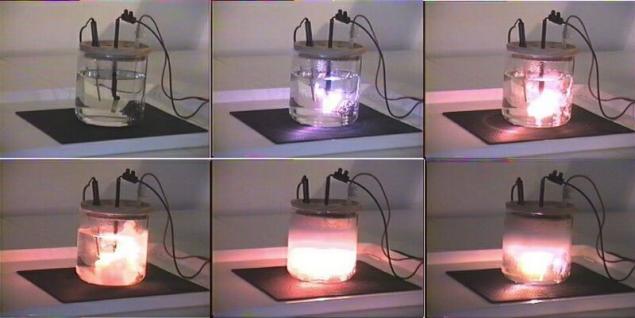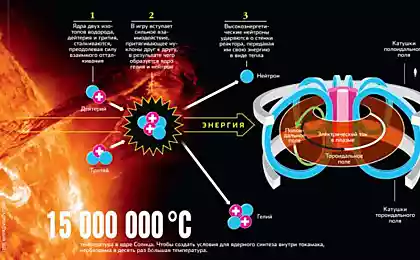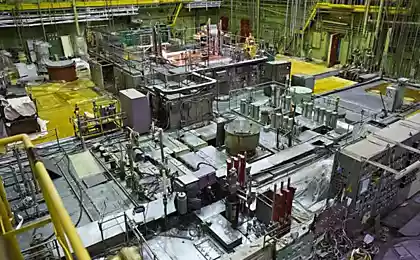674
Cold fusion: myth and reality
March 23, 1989 University of Utah announced in a press release that "two scientists have launched a self-sustaining reaction of nuclear fusion at room temperature". University President chase Peterson said that this landmark achievement is comparable only with the mastery of fire, discovery of electricity and cultivation of plants. State lawmakers urgently allocated $5 million for the establishment of the National cold fusion Institute, and the University has requested from Congress another 25 million So began one of the biggest scientific scandals of the twentieth century. Print and television instantly spread the news around the world.
Scientists made a sensational statement, had a solid reputation and quite trustworthy. Migrated to USA from the UK fellow of the Royal society and former President of the International society of electrochemistry Martin Fleischmann had the international reputation earned through participation in the discovery of surface-enhanced Raman light scattering. The co-discoverer Stanley Pons was the head of the chemistry Department of the University of Utah.
So what it still a myth or reality?
A source of cheap energy
Fleischmann and Pons claimed that they forced deuterium nucleus to merge with each other at normal temperatures and pressures. Their "cold fusion reactor" was a calorimeter with an aqueous salt solution through which an electrical current was passed. However, the water was not simple, but heavy, D2O, the cathode was made of palladium, and the composition of the dissolved salt includes lithium and deuterium. Using the solution for months non-stop was passed constant current, so that the anode of released oxygen and the cathode — heavy hydrogen. Fleischmann and Pons allegedly found that the temperature of the electrolyte was periodically increased by tens of degrees, and sometimes more, although the power source gave consistent power. They explained that the arrival of nuclear energy released by fusion of deuterium nuclei.
Palladium has the unique ability to absorb hydrogen. Fleischmann and Pons believed that inside the crystal lattice of the metal atoms of deuterium so much closer together that their nuclei merge into a nucleus of the main isotope of helium. This process goes with the release of energy, which, according to their hypothesis had to heat the electrolyte. Explanation bribed simplicity and quite convinced politicians, journalists and even chemists.
Physics bring clarity
However, nuclear physicists and specialists in plasma physics were not in a hurry to beat the drums. They knew that two of the deuteron can, in principle, give rise to a nucleus of helium-4 and highly energetic gamma-quantum, but the chances of such an outcome is extremely small. Even if the deuterons enter into a nuclear reaction, it almost certainly ends with the birth of a tritium nucleus and a proton or the appearance of the neutron and the nuclei of helium-3, and the probabilities of these transitions are about the same. If the inside of palladium really is fusion, it must produce a large number of neutrons of a definite energy (about 2.45 MeV). They are easy to detect, either directly (with the help of neutron detectors), or indirectly (as in the collision of such a neutron with the nucleus of heavy hydrogen needs to occur a gamma quantum with energy of 2.22 MeV, which, again, lends itself to registration). In General, the hypothesis of Fleischmann and Pons could be validated using standard radiometric instruments.
However, this did not work. Fleishman used the connection at home and convinced employees of the British nuclear center in Harwell to check his "reactor" for the generation of neutrons. Harwell had super-sensitive detectors of these particles, but they showed nothing! Search gamma rays of corresponding energy, too, was a failure. The same conclusion came and physics from the University of Utah. The staff of the Massachusetts Institute of technology tried to reproduce the experiments of Fleischmann and Pons, but again to no avail. It is therefore not surprising that the demand for the great discovery had undergone a crushing defeat at the conference of the American physical society (AFO), which met in Baltimore may 1 of that year.

Sic transit gloria mundi
From this blow Pons and Fleishman longer recovered. In the New York Times there was a devastating article, and by the end of may the scientific community has come to the conclusion that the claims of chemists from Utah or a manifestation of extreme incompetence or a basic Scam.
But there were also dissidents, even among the scientific elite. Eccentric Nobel laureate Julian Schwinger, one of the founders of quantum electrodynamics, so believed in the discovery chemists from salt lake city, in protest canceled its membership in the AFO.
However, the academic career of Fleischmann and Pons ended quickly and ignominiously. In 1992 they resigned from the University of Utah and Japanese money continued its work in France until they lost this funding. Fleishman returned to England, where he lives retired. Pons renounced his U.S. citizenship and settled in France.

Pyroelectric cold fusion
Cold fusion on desktop devices are not only possible, but implemented, and in several versions. So, in 2005, researchers from the University of California at Los Angeles managed to start a similar reaction in a container with deuterium, inside of which was created by an electrostatic field. His sources were a tungsten needle attached to the pyroelectric crystal of lithium tantalate, during cooling and subsequent heating, which created a potential difference of 100-120 kV. The field intensity of 25 GW/m fully ionized deuterium atoms dispersed and so its core that when faced with a target of erbium deuteride these gave rise to the nuclei of helium-3 and neutrons. The peak neutron flux was of the order of 900 neutrons per second (several hundred times above typical background values). Although this system has potential as a generator of neutrons, talking about it as a source of power. Such devices consume far more energy than generated in the experiments, the California scientists in one cycle of heating and cooling lasting a few minutes were allocated approximately 10-8 j (11 orders of magnitude less than needed to heat Cup of water 1°C).
The story does not end
In the beginning of 2011 in the world of science had again flared up interest in cold fusion, or as it is called domestic physics, cold fusion. The reason for this excitement was the demonstration of Italian scientists Sergio Focardi and Andrea Rossi of the University of Bologna, an unusual setup in which, according to its developers, this synthesis is carried out easily enough.
In General terms, this machine works. In a metal tube with an electric heater placed nanopowder of Nickel and ordinary hydrogen isotope. Further build up of pressure about 80 atmospheres. Upon initial heating to high temperatures (hundreds of degrees), as scientists say, part of the H2 molecules are split into atomic hydrogen, then that enters into a nuclear reaction with Nickel.
The result of this reaction is generated by the isotope of copper, and a large amount of heat energy. Andrea Rossi explained that the first testing of the device they received from him about 10-12 kilowatts output while at the input, the system required on average 600-700 watt (mean power supplied to the device when you plug into the outlet). Around it turned out that energy production in this case was many times higher cost, and it is precisely this effect at the time expected from cold fusion.
However, according to the developers, this device while reacts not all hydrogen and Nickel, a very small proportion. However, scientists believe that what happens inside, is a nuclear reaction. A proof of this they say: the appearance of copper in greater quantities than could be impurity in the source "fuel" (Nickel); the lack of a large (i.e., measurable) hydrogen consumption (because he could act as fuel in chemical reactions); emitted thermal radiation; and, of course, he's energy balance.
So, is the Italian physicists still managed to achieve fusion at low temperatures (hundreds of degrees Celsius is nothing for such reactions, which usually are in the millions of degrees Kelvin!)? Hard to say, because so far, all peer-reviewed scientific journals have even rejected the article its authors. The skepticism of many scientists is quite understandable — for many years the words "cold fusion" cause physicists a smile and the Association with perpetual motion. In addition, the drafters of the device honestly admit that the subtle details of his work are still beyond their comprehension.
What is this such an elusive cold fusion, to prove the possibility of occurrence of which many scientists are trying for decades? In order to understand the nature of this reaction, as well as the perspectives of such studies, let's first talk about what is actually fusion. This term is understood as the process by which the synthesis of heavier atomic nuclei from lighter ones. This releases huge amounts of energy, far more than in the nuclear reactions decay of radioactive elements.
Such processes are constantly occurring in the Sun and other stars, which they can provide both light and heat. For example, every second our Sun emits into space energy equivalent to four million tons of mass. This energy is born in the course of mergers of four hydrogen nuclei (protons) to helium nucleus. At the output of the result of the conversion of one gram of protons is released in 20 million times more energy than burning a gram of coal. Agree, this is very impressive.
But do people can't build a reactor like the Sun, to produce large amounts of energy for their needs? Theoretically, of course, you can, as a direct ban on such a device does not install none of the laws of physics. However, doing so is difficult, and here's why: this synthesis requires a very high temperature and incredibly high pressure. Therefore, the creation of classic fusion reactor turns out is economically unprofitable — then, to run it, you will need to expend a lot more energy than he can develop over the next few years.
Returning to the Italian pioneers have to admit that themselves "scientists" do not inspire much confidence, nor their past achievements or current situation. Name Sergio Focardi until now has been little known, but thanks to the academic title of Professor, you can at least be no doubt of his involvement in the science. But in relation to colleagues at the opening, Andrea Rossi, this is not to say. At the moment Andrea is a member of some American corporations, Leonardo Corp, and at the time, distinguished only by a prosecution for tax evasion and smuggling of silver from Switzerland. But this "bad" news for advocates of cold fusion has not ended. It turned out that the scientific journal journal of Nuclear Physics which was published the article of the Italians of its opening, really more of a blog, and defective magazine. And, in addition, it was not who other, as already familiar to the Italians Sergio Focardi and Andrea Rossi. But the publication in major scientific journals confirms the "plausibility" of the opening.
Not stopping there, and dropping even deeper, reporters also found that the idea of the presented project is committed to another person — Italian scientist Francesco Piantelli. It seems that at the same time, ignominiously ended the next sensation, and the world once again lost his "eternal engine". But, not without irony, console themselves with the Italians, if it's just fiction, then at least she's not devoid of wit, it's one thing to play friends and quite another to try to cheat the whole world.

But...
Currently, all of the rights to this device owned by an American company Industrial Heat, where Rossi leads all research and development activities in respect of reactor.
There are low-temperature (E-Cat) and high temperature (Hot Cat) version of the reactor. The first for temperatures about 100-200 °C, the second for temperatures of the order of 800-1400 °C. currently, the company has sold low-temperature reactor 1mW unnamed customer for commercial use and, in particular, in this reactor, Industrial Heat testing and debugging in order to launch a full-scale industrial production of such energy blocks. As claimed by Andrea Rossi, the reactor is operated mainly by the reaction between Nickel and hydrogen, which is the transmutation of isotopes of Nickel with a large amount of heat. I.e., some isotopes of Nickel are attracted to other isotopes. Nevertheless, a series of independent trials, the most informative of which was a test version of the high temperature reactor in the Swiss city of Lugano. About this test already wrote here.

In 2012 it was reported that sold the first installation of cold fusion Rossi.
December 27 on the website E-Cat World has published an article about the independent reproduction of Rossi's reactor in Russia. The same article contains a reference to the report "Study analogue high-temperature heat generator Rossi" physics Parkhomov Alexander Georgievich. Report prepared for the all-Russian physics seminar "Cold fusion and ball lightning", which was held on 25 September 2014 at the Russian University of friendship of peoples.
In the report, the author presented his version of Rossi's reactor, data on its internal structure and the tests. Main conclusion: the reactor really produces more energy than it consumes. The ratio of allocated heat to the consumed energy amounted to 2.58. Moreover, about 8 minutes, the reactor worked without input power, once the power lead is blown, thus producing about a kilowatt of thermal power output.

In 2015, A. G. Parkhomov managed to make a continuously operating reactor with the pressure test. From 23:30 on 16 March the temperature is still. Photo of the reactor.
Finally managed to make a continuously operating reactor. Temperature 1200оС reached at 23:30 on 16 March after a 12 - hour gradual heat, and kept still. The power of the heater is 300 watts, COP=3.
For the first time successfully managed to integrate the installation of the pressure gauge. At slow heating maximum pressure of 5 bar was achieved at 200oC, and then the pressure was decreased and at a temperature of about 1000 ° C became negative. The most powerful vacuum of about 0.5 bar was at a temperature of 1150оС.
During prolonged continuous operation there is no possibility round the clock to add water. So I had to abandon used in the previous experiments calorimetry is based on measuring the mass of evaporated water. The determination of thermal coefficient in this experiment is performed by comparing the consumed electric power in the presence and absence of the fuel mixture. Without fuel temperature 1200оС is achieved at a power of about 1070 watts. With fuel (630 mg Nickel +60 mg of lithium aluminum hydride), such a temperature is reached at a power of about 330 watts. Thus, the reactor produces about 700 watts of redundant power (COP ~ 3,2). (Explanation Parkhomov A. G., a more accurate value of COP requires more detailed calculation). published
SUBSCRIBE to OUR youtube channel that allows you to watch online, download from YouTube free video about the recovery, the rejuvenation of man. Love for others and ourselves, as the feeling of high vibrations — an important factor for improvement .
Put LIKES and share with your FRIENDS!
www.youtube.com/channel/UCXd71u0w04qcwk32c8kY2BA/videos
P. S. And remember, only by changing their consumption — together we change the world! ©
Source: oko-planet.su/science/sciencehypothesis/330348-holodnyy-sintez-mif-i-realnost.html
Scientists made a sensational statement, had a solid reputation and quite trustworthy. Migrated to USA from the UK fellow of the Royal society and former President of the International society of electrochemistry Martin Fleischmann had the international reputation earned through participation in the discovery of surface-enhanced Raman light scattering. The co-discoverer Stanley Pons was the head of the chemistry Department of the University of Utah.
So what it still a myth or reality?
A source of cheap energy
Fleischmann and Pons claimed that they forced deuterium nucleus to merge with each other at normal temperatures and pressures. Their "cold fusion reactor" was a calorimeter with an aqueous salt solution through which an electrical current was passed. However, the water was not simple, but heavy, D2O, the cathode was made of palladium, and the composition of the dissolved salt includes lithium and deuterium. Using the solution for months non-stop was passed constant current, so that the anode of released oxygen and the cathode — heavy hydrogen. Fleischmann and Pons allegedly found that the temperature of the electrolyte was periodically increased by tens of degrees, and sometimes more, although the power source gave consistent power. They explained that the arrival of nuclear energy released by fusion of deuterium nuclei.
Palladium has the unique ability to absorb hydrogen. Fleischmann and Pons believed that inside the crystal lattice of the metal atoms of deuterium so much closer together that their nuclei merge into a nucleus of the main isotope of helium. This process goes with the release of energy, which, according to their hypothesis had to heat the electrolyte. Explanation bribed simplicity and quite convinced politicians, journalists and even chemists.
Physics bring clarity
However, nuclear physicists and specialists in plasma physics were not in a hurry to beat the drums. They knew that two of the deuteron can, in principle, give rise to a nucleus of helium-4 and highly energetic gamma-quantum, but the chances of such an outcome is extremely small. Even if the deuterons enter into a nuclear reaction, it almost certainly ends with the birth of a tritium nucleus and a proton or the appearance of the neutron and the nuclei of helium-3, and the probabilities of these transitions are about the same. If the inside of palladium really is fusion, it must produce a large number of neutrons of a definite energy (about 2.45 MeV). They are easy to detect, either directly (with the help of neutron detectors), or indirectly (as in the collision of such a neutron with the nucleus of heavy hydrogen needs to occur a gamma quantum with energy of 2.22 MeV, which, again, lends itself to registration). In General, the hypothesis of Fleischmann and Pons could be validated using standard radiometric instruments.
However, this did not work. Fleishman used the connection at home and convinced employees of the British nuclear center in Harwell to check his "reactor" for the generation of neutrons. Harwell had super-sensitive detectors of these particles, but they showed nothing! Search gamma rays of corresponding energy, too, was a failure. The same conclusion came and physics from the University of Utah. The staff of the Massachusetts Institute of technology tried to reproduce the experiments of Fleischmann and Pons, but again to no avail. It is therefore not surprising that the demand for the great discovery had undergone a crushing defeat at the conference of the American physical society (AFO), which met in Baltimore may 1 of that year.

Sic transit gloria mundi
From this blow Pons and Fleishman longer recovered. In the New York Times there was a devastating article, and by the end of may the scientific community has come to the conclusion that the claims of chemists from Utah or a manifestation of extreme incompetence or a basic Scam.
But there were also dissidents, even among the scientific elite. Eccentric Nobel laureate Julian Schwinger, one of the founders of quantum electrodynamics, so believed in the discovery chemists from salt lake city, in protest canceled its membership in the AFO.
However, the academic career of Fleischmann and Pons ended quickly and ignominiously. In 1992 they resigned from the University of Utah and Japanese money continued its work in France until they lost this funding. Fleishman returned to England, where he lives retired. Pons renounced his U.S. citizenship and settled in France.

Pyroelectric cold fusion
Cold fusion on desktop devices are not only possible, but implemented, and in several versions. So, in 2005, researchers from the University of California at Los Angeles managed to start a similar reaction in a container with deuterium, inside of which was created by an electrostatic field. His sources were a tungsten needle attached to the pyroelectric crystal of lithium tantalate, during cooling and subsequent heating, which created a potential difference of 100-120 kV. The field intensity of 25 GW/m fully ionized deuterium atoms dispersed and so its core that when faced with a target of erbium deuteride these gave rise to the nuclei of helium-3 and neutrons. The peak neutron flux was of the order of 900 neutrons per second (several hundred times above typical background values). Although this system has potential as a generator of neutrons, talking about it as a source of power. Such devices consume far more energy than generated in the experiments, the California scientists in one cycle of heating and cooling lasting a few minutes were allocated approximately 10-8 j (11 orders of magnitude less than needed to heat Cup of water 1°C).
The story does not end
In the beginning of 2011 in the world of science had again flared up interest in cold fusion, or as it is called domestic physics, cold fusion. The reason for this excitement was the demonstration of Italian scientists Sergio Focardi and Andrea Rossi of the University of Bologna, an unusual setup in which, according to its developers, this synthesis is carried out easily enough.
In General terms, this machine works. In a metal tube with an electric heater placed nanopowder of Nickel and ordinary hydrogen isotope. Further build up of pressure about 80 atmospheres. Upon initial heating to high temperatures (hundreds of degrees), as scientists say, part of the H2 molecules are split into atomic hydrogen, then that enters into a nuclear reaction with Nickel.
The result of this reaction is generated by the isotope of copper, and a large amount of heat energy. Andrea Rossi explained that the first testing of the device they received from him about 10-12 kilowatts output while at the input, the system required on average 600-700 watt (mean power supplied to the device when you plug into the outlet). Around it turned out that energy production in this case was many times higher cost, and it is precisely this effect at the time expected from cold fusion.
However, according to the developers, this device while reacts not all hydrogen and Nickel, a very small proportion. However, scientists believe that what happens inside, is a nuclear reaction. A proof of this they say: the appearance of copper in greater quantities than could be impurity in the source "fuel" (Nickel); the lack of a large (i.e., measurable) hydrogen consumption (because he could act as fuel in chemical reactions); emitted thermal radiation; and, of course, he's energy balance.
So, is the Italian physicists still managed to achieve fusion at low temperatures (hundreds of degrees Celsius is nothing for such reactions, which usually are in the millions of degrees Kelvin!)? Hard to say, because so far, all peer-reviewed scientific journals have even rejected the article its authors. The skepticism of many scientists is quite understandable — for many years the words "cold fusion" cause physicists a smile and the Association with perpetual motion. In addition, the drafters of the device honestly admit that the subtle details of his work are still beyond their comprehension.
What is this such an elusive cold fusion, to prove the possibility of occurrence of which many scientists are trying for decades? In order to understand the nature of this reaction, as well as the perspectives of such studies, let's first talk about what is actually fusion. This term is understood as the process by which the synthesis of heavier atomic nuclei from lighter ones. This releases huge amounts of energy, far more than in the nuclear reactions decay of radioactive elements.
Such processes are constantly occurring in the Sun and other stars, which they can provide both light and heat. For example, every second our Sun emits into space energy equivalent to four million tons of mass. This energy is born in the course of mergers of four hydrogen nuclei (protons) to helium nucleus. At the output of the result of the conversion of one gram of protons is released in 20 million times more energy than burning a gram of coal. Agree, this is very impressive.
But do people can't build a reactor like the Sun, to produce large amounts of energy for their needs? Theoretically, of course, you can, as a direct ban on such a device does not install none of the laws of physics. However, doing so is difficult, and here's why: this synthesis requires a very high temperature and incredibly high pressure. Therefore, the creation of classic fusion reactor turns out is economically unprofitable — then, to run it, you will need to expend a lot more energy than he can develop over the next few years.
Returning to the Italian pioneers have to admit that themselves "scientists" do not inspire much confidence, nor their past achievements or current situation. Name Sergio Focardi until now has been little known, but thanks to the academic title of Professor, you can at least be no doubt of his involvement in the science. But in relation to colleagues at the opening, Andrea Rossi, this is not to say. At the moment Andrea is a member of some American corporations, Leonardo Corp, and at the time, distinguished only by a prosecution for tax evasion and smuggling of silver from Switzerland. But this "bad" news for advocates of cold fusion has not ended. It turned out that the scientific journal journal of Nuclear Physics which was published the article of the Italians of its opening, really more of a blog, and defective magazine. And, in addition, it was not who other, as already familiar to the Italians Sergio Focardi and Andrea Rossi. But the publication in major scientific journals confirms the "plausibility" of the opening.
Not stopping there, and dropping even deeper, reporters also found that the idea of the presented project is committed to another person — Italian scientist Francesco Piantelli. It seems that at the same time, ignominiously ended the next sensation, and the world once again lost his "eternal engine". But, not without irony, console themselves with the Italians, if it's just fiction, then at least she's not devoid of wit, it's one thing to play friends and quite another to try to cheat the whole world.

But...
Currently, all of the rights to this device owned by an American company Industrial Heat, where Rossi leads all research and development activities in respect of reactor.
There are low-temperature (E-Cat) and high temperature (Hot Cat) version of the reactor. The first for temperatures about 100-200 °C, the second for temperatures of the order of 800-1400 °C. currently, the company has sold low-temperature reactor 1mW unnamed customer for commercial use and, in particular, in this reactor, Industrial Heat testing and debugging in order to launch a full-scale industrial production of such energy blocks. As claimed by Andrea Rossi, the reactor is operated mainly by the reaction between Nickel and hydrogen, which is the transmutation of isotopes of Nickel with a large amount of heat. I.e., some isotopes of Nickel are attracted to other isotopes. Nevertheless, a series of independent trials, the most informative of which was a test version of the high temperature reactor in the Swiss city of Lugano. About this test already wrote here.

In 2012 it was reported that sold the first installation of cold fusion Rossi.
December 27 on the website E-Cat World has published an article about the independent reproduction of Rossi's reactor in Russia. The same article contains a reference to the report "Study analogue high-temperature heat generator Rossi" physics Parkhomov Alexander Georgievich. Report prepared for the all-Russian physics seminar "Cold fusion and ball lightning", which was held on 25 September 2014 at the Russian University of friendship of peoples.
In the report, the author presented his version of Rossi's reactor, data on its internal structure and the tests. Main conclusion: the reactor really produces more energy than it consumes. The ratio of allocated heat to the consumed energy amounted to 2.58. Moreover, about 8 minutes, the reactor worked without input power, once the power lead is blown, thus producing about a kilowatt of thermal power output.

In 2015, A. G. Parkhomov managed to make a continuously operating reactor with the pressure test. From 23:30 on 16 March the temperature is still. Photo of the reactor.
Finally managed to make a continuously operating reactor. Temperature 1200оС reached at 23:30 on 16 March after a 12 - hour gradual heat, and kept still. The power of the heater is 300 watts, COP=3.
For the first time successfully managed to integrate the installation of the pressure gauge. At slow heating maximum pressure of 5 bar was achieved at 200oC, and then the pressure was decreased and at a temperature of about 1000 ° C became negative. The most powerful vacuum of about 0.5 bar was at a temperature of 1150оС.
During prolonged continuous operation there is no possibility round the clock to add water. So I had to abandon used in the previous experiments calorimetry is based on measuring the mass of evaporated water. The determination of thermal coefficient in this experiment is performed by comparing the consumed electric power in the presence and absence of the fuel mixture. Without fuel temperature 1200оС is achieved at a power of about 1070 watts. With fuel (630 mg Nickel +60 mg of lithium aluminum hydride), such a temperature is reached at a power of about 330 watts. Thus, the reactor produces about 700 watts of redundant power (COP ~ 3,2). (Explanation Parkhomov A. G., a more accurate value of COP requires more detailed calculation). published
SUBSCRIBE to OUR youtube channel that allows you to watch online, download from YouTube free video about the recovery, the rejuvenation of man. Love for others and ourselves, as the feeling of high vibrations — an important factor for improvement .
Put LIKES and share with your FRIENDS!
www.youtube.com/channel/UCXd71u0w04qcwk32c8kY2BA/videos
P. S. And remember, only by changing their consumption — together we change the world! ©
Source: oko-planet.su/science/sciencehypothesis/330348-holodnyy-sintez-mif-i-realnost.html
Back to school: rules of adaptation of the parent and the child for school life
Fast and live longer!























